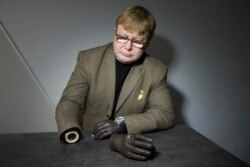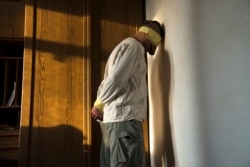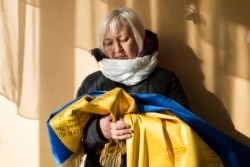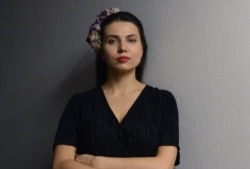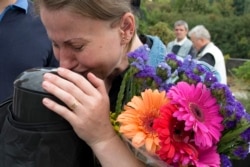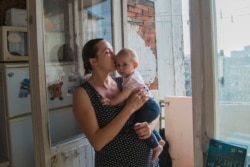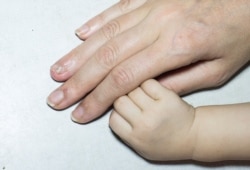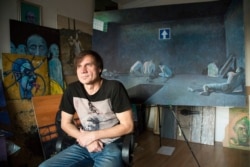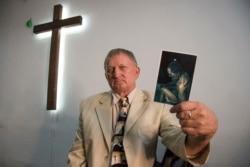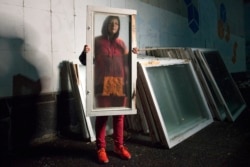Associated Press contributor Zoya Shu, a photographer based in Kyiv, has been covering Ukraine's conflict with Russia-backed separatists in eastern Ukraine, documenting the fates of prisoners in a war that has claimed more than 13,000 lives since it began in 2014.
In many cases, the captives are not combatants but ordinary people, singled out by the separatists for their participation in protests or their activities on social media.
Shu's work became a labor of love that she has shared with the world on her website, called After Captivity.
There have been two prisoner exchanges since Ukrainian President Volodymyr Zelenskiy came to power in May 2019 -- one in September and the other in late December.
Shu focuses on the pain and injuries -- both physical and mental -- of those who have been released.
Volodymyr Zhemchuhov spent a year held captive by Russia-backed separatists before he was released in a prisoner swap. He is wearing a Gold Star Hero of Ukraine medal. He was captured after he was injured by a land mine.
"Captivity is not the same as imprisonment. Prison has its rules, but when someone is taken hostage and unlawfully held against their will, unthinkable things can happen," Shu says on her English-language website.*
"People are kept in cellars on absurd allegations, for ransom or as human shields, without sunlight, fresh air, food or a toilet. They face beatings, rape and torture, and they never know when and if they will be released."
Dmytro Kluher, wearing a robe he was given in captivity, shows how he was tied up in an underground dungeon. Russia-backed separatists detained him in the spring of 2015.
"The wanton use of violence towards civilians, in particular those in captivity, is a crime against humanity and can be considered a means of psychological warfare aimed at humiliating, dehumanizing and de-socializing the population in an armed conflict zone," Shu says.
Tetyana Borysenko holds a Ukrainian flag that she hid from her captors throughout her time in prison. It's signed by 12 people who were held with her. Borysenko was a military medic in the volunteer Aidar battalion. She was captured in September 2015.
RFE/RL Russian Service correspondent Oleksandra Vagner interviewed Shu about her work. The interview was conducted in Russian:
RFE/RL: Your series shows people in an unusual way. Many of them demonstrate what happened to them in prison and during torture. How did you persuade them to tell their stories? Was it difficult to convince Bohdan Serhiyets, the man with a swastika carved on his back, to show it? Reliving such moments of the past must have been a grave experience for these people.
ZOYA SHU: When I started working on this series, I tried to be as delicate as I could because I’d never dealt with such issues before. I knew that if I wanted them to open up I had to meet them halfway, to be more open.
Photographer Zoya Shu: "My series is about survivors, not victims."
It was a transformational experience for me. It was a new style of communication. I started to make friends and interact.
As for the young man with a scar on his back, he only spent 10 hours in captivity. He didn’t even know that there is a movement for war prisoners’ rights and that the people who have survived captivity are trying to receive support from the government. We started talking, and I asked him cautiously if I could take a picture of his scar, and he said: "Yes, of course."
Tetyana kisses an urn containing the ashes of her husband, Oleksandr, who was captured by separatists in 2018. He died a year after his release.
Before releasing the photo, I asked if he wanted me to omit his name, but he insisted that I publish it because he wanted everyone to know. There has been a lot of talk about the prisoner exchanges [themselves], but [the prisoners] have to live with this [reality]. Talking about it publicly may have a therapeutic effect for those who survived captivity. Besides, it’s a search for justice.
RFE/RL: You are saying that some of the former prisoners don’t know that they are eligible for help from the government. Does it mean that they are left on their own after they are released?
SHU: Yes, I’m talking about the civilians. Not all of them who were freed came as a result of a prisoner swap. Some paid a ransom. Others were just lucky: They were released because someone interfered or they were simply let go. Those are completely different stories.
Russia-backed separatists arrested Hanna Serhiyeva, a former real-estate agent, in her home. She spent six days in prison. As a civilian, Serhiyeva doesn’t have the status of a former prisoner of war and receives no governmental support. She currently lives on the outskirts of Kyiv with her two children.
Serhiyeva says she was beaten regularly. In one incident of torture, her captors severely injured her finger. The wound is still visible.
A few thousand people are estimated to have been captured. There is no precise data. Most of them are trying to forget everything or have already forgotten. They see it as a story from the past. Many are left to survive, as there’s not a systematic solution for their problems.
RFE/RL: The prisoners have different backgrounds. They belong to different social groups, have different educations, are of different ages, and have had different experiences. Most of them survived torture, but the story of each one is unique. Did you feel anything that they have in common when you talked to them and photographed them?
SHU: They share a traumatic experience that has affected them deeply. We’ve all experienced stressful situations and we know that you need resources to recover. Those who survived extreme violence and stress need more resources. That’s why they need comprehensive governmental support.
Artist Serhiy Zakharov says he was tortured by his captors. According to him, three times he was taken outside for an execution by a firing squad. Captivity is a subject of one of his graphic series. This photo was taken in his studio in Kyiv.
Besides, this situation affects the society in general, as there are many people who survived captivity and war. They are plenty, and their trauma is very deep. We need to realize this and do something about it systematically and comprehensively.
RFE/RL: Your project is focused on grave experiences but somehow it feels a little optimistic. Let’s take, for example, the story of the priest, Vitaliy Paraskun. He was kept in a cellar in brutal conditions, but he still found the strength to preach to his cellmates. Later, he found strength to leave the past behind and move on.
SHU: My series is about survivors, not victims. These people have survived, so it’s a positive project, but its goal is to start a discussion about the traumatization of our society. Of course, this project is about very strong people who found the inner resources to live on without any governmental support. It’s the positive side of it.
Priest Vitaliy Paraskun shows a photo of himself taken shortly after he was released after being tortured for 199 days in an unheated basement filled with rats. He says he doesn't hold a grudge against his torturers. He's happy that he persuaded four people in the prison to become believers.
My series features a Spaniard who spent a month in captivity. He said that the traditional concept of treating a "victim" with superiority and condescendence is wrong and the people who have survived this horrible experience should not be seen as victims: They don’t need our compassion.
We usually demonstrate compassion as a ritual. We think that since we have expressed our compassion we may move on. The people who survived traumatic situations must be respected and their opinions heard. They potentially can make a more valuable contribution than those who call themselves experts in this field.
Besides, they have additional resources, some additional value, so they shouldn’t be downgraded to victims with passive needs. They can make a very positive contribution to the development of society.
Olga asked not to reveal her last name because she still fears for her life. She was detained by Russia-backed separatists in her hometown of Alchevsk in August 2014. She says she was threatened with execution three times in less than two weeks. Once, she says, her captors put a grenade under her shirt. Ten days later, her girlfriend successfully negotiated her release.
Shu says that her meetings with the former prisoners of war have changed her.
“You become more considerate with others because you don’t know, maybe they have survived a terrible experience, too,” she says.
* This story has been updated to reflect the text on Shu's English-language website, as well as her conversation with RFE/RL Russian Service correspondent Oleksandra Vagner. That conversation was translated into English from the original Russian and the updated version of the story has minor changes in the translation.





